Bulletin – September 2014 Australian Economy The Determinants of Non-tradables Inflation
- Download the article 391KB
This article examines the factors that explain inflation in prices of non-tradable items in the CPI. Non-tradable goods and services by definition have relatively little exposure to international competition. Consequently, their prices are more likely to be influenced by developments in the domestic economy, particularly the extent of spare capacity in both production and the labour market. A more granular breakdown of prices highlights the importance of conditions in individual markets, such as housing, as well as non-market influences on prices.
Introduction
The Reserve Bank's inflation target is specified in terms of CPI inflation. However, in understanding and forecasting developments in overall inflation, it can be useful to examine separate components of the CPI basket. In a small open economy such as Australia, the basket of goods and services consumed by households can be divided into ‘non-tradable’ items and ‘tradable’ items. Non-tradable items are exposed to a low degree of international competition. This includes many services that can (in most cases) only be provided locally, such as hairdressing, medical treatment or electricity. The prices of these items should be driven mainly by domestic developments. Therefore, inflation for non-tradable items should provide a relatively good sense of the extent to which demand exceeds (or falls short) of supply in the domestic economy. In contrast, tradable items are much more exposed to international competition. This includes many imported manufactured goods such as televisions and computers, as well as some food items and services such as international travel. The prices of these items should be less influenced by conditions in the Australian economy, and more affected by prices set on world markets and fluctuations in the exchange rate.
Indeed, there have been large differences in inflation outcomes for non-tradable and tradable items over the past two decades (Graph 1). Non-tradables inflation has been higher and more stable than tradables inflation, although both series have cycled around their respective averages.
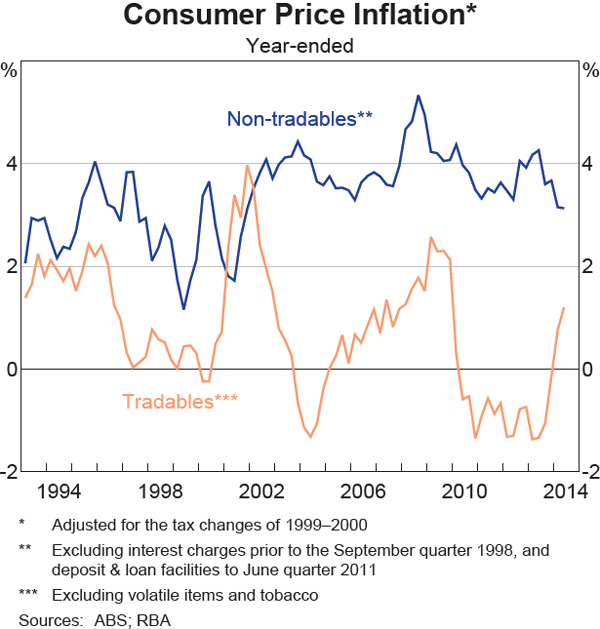
There is relatively little published analysis of the factors that influence non-tradables inflation in Australia, with more work having focused on the determinants of tradables inflation.[1] This article outlines the main characteristics of non-tradable items in the CPI. It then examines the factors that are relevant to inflation in the prices of non-tradable items from two complementary perspectives: a ‘top-down’, or macroeconomic perspective, and a ‘bottom-up’, or disaggregated perspective.
Which Items are Non-tradable?
In practice, drawing a precise distinction between a tradable and a non-tradable item is difficult. The exposure of an item to international competition is both complicated to measure and a matter of degree. The Australian Bureau of Statistics (ABS) classifies an item as tradable where the proportion of final imports or exports of that item exceeds a given threshold of the total domestic supply.[2] Any item not meeting this definition is classified as a non-tradable. In general, many goods are classified as tradable while nearly all services are classified as non-tradable.
Currently, non-tradable items make up around 60 per cent of household spending and tradable items comprise about 40 per cent (Graph 2). The share of spending on non-tradable items has risen noticeably over the past couple of decades. This reflects larger price increases for non-tradable items and a shift in consumer preferences towards non-tradable items (discussed in more detail below).
The importance of domestic influences for the prices of non-tradable items is apparent from looking at their cost structure. In particular, around 90 per cent of the final price paid for these items reflects domestic costs (Graph 3). This includes both wages paid to the local labour that is employed to produce and distribute the item, as well as margins paid to the owners of local capital used along the supply chain. In contrast, the domestic share of input costs is smaller for tradable items.[3]

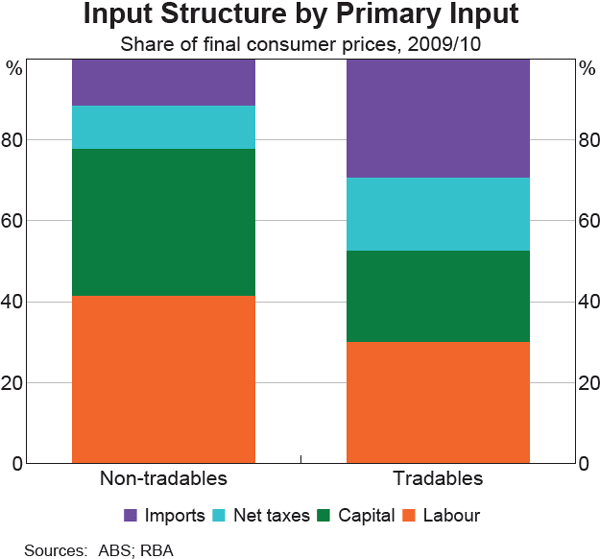
Imported inputs account for only a small share of the prices of non-tradable items – about 10 per cent, compared with 30 per cent for tradable items.[4] This means that world prices and the exchange rate typically have a relatively small direct impact on prices of non-tradable items. However, the exchange rate has an indirect influence on the prices of non-tradable items. For example, a depreciation is likely to induce consumers to spend less on tradable items (e.g. books) and more on non-tradable items (e.g. dining out), providing scope for sellers to raise their prices.
The Macroeconomic (‘Top-down’) Perspective
The top-down perspective focuses on two broad characteristics of non-tradables inflation: its higher average rate over the long-run compared with that of tradable items; and the fluctuations seen over the business cycle.
Long-run developments
Since the introduction of inflation targeting in Australia in 1993, CPI inflation has averaged around 2½ per cent, in the middle of the Reserve Bank's inflation target.[5] However, over this period the average rate of non-tradables inflation has been significantly above that of tradables inflation, resulting in a large rise in the relative price of non-tradables (Graph 4). This increase in relative prices is not unique to Australia; it is evident across a range of countries (Steenkamp 2013).
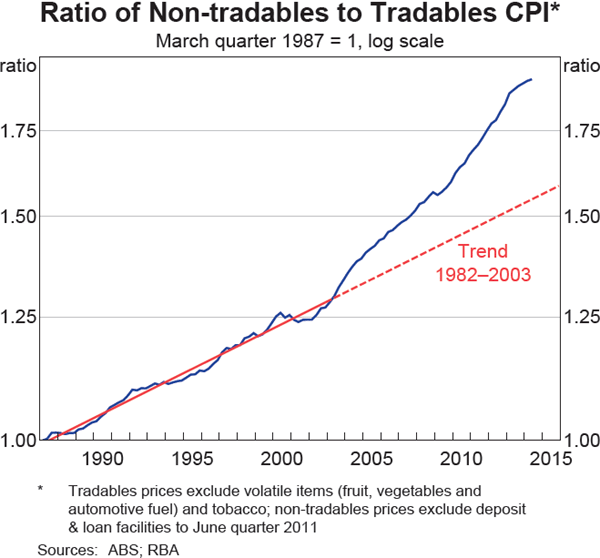
Both supply and demand forces explain the relative increase in prices of non-tradable items. On the supply side, there is the Balassa-Samuelson effect whereby productivity in the tradable sector tends to rise more quickly than in the non-tradable sector (Balassa 1964; Samuelson 1964). This productivity growth pushes up demand for labour in the tradable sector, which tends to lift wages across the economy (assuming labour is mobile across sectors). Higher wages push up the prices of non-tradable items while prices of tradable items, which are determined in international markets, are not pushed higher. Over the past 20 years, this effect appears to have been present in the data – although not by enough to fully explain the shift in relative prices (Graph 5). An additional supply-side factor influencing relative prices has been the integration of China into the global trading system, which tended to lead to lower prices of a wide range of tradable goods.
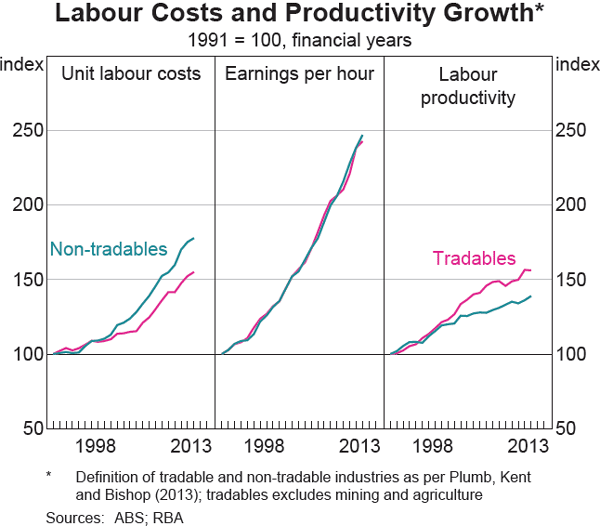
A shift in consumer demand appears to have also contributed to a rise in the relative price of non-tradable items. This is because rising wealth is typically associated with a shift in demand towards services (which tend to be non-tradable) away from goods (which tend to be tradable).
Over the past decade, the increase in the relative price of non-tradable items in Australia has accelerated, as can be seen in Graph 4. This is likely to reflect the structural adjustment of the Australian economy over this period, associated with the boom in the terms of trade (Plumb, Kent and Bishop 2013). The higher terms of trade acted to bolster demand for labour while the addition to incomes increased demand for non-tradable goods and services.
In addition, the associated appreciation of the nominal exchange rate reduced demand for some domestically produced tradable items and also lowered import prices and tradables inflation. Over the past year, however, these forces have partially reversed, as the terms of trade declined and the exchange rate depreciated somewhat.
Business cycle developments
The rate of non-tradables inflation is also affected by the business cycle. When there is spare capacity in the economy, there tends to be slower growth in wages and firms are constrained in their ability to expand margins. For example, during much of the 1990s, slow growth in prices of non-tradable items coincided with a high unemployment rate and slow growth in labour costs (Table 1). Conversely, during periods of little spare capacity in the economy, there is upward pressure on wages and margins and firms face constraints in expanding production. As a result, growth in demand tends to result in higher prices rather than higher output. This was the case over much of the 2000s, with a lower unemployment rate and faster growth in labour costs and non-tradables prices on average.
An econometric model of non-tradables inflation can be estimated in order to better understand these relationships. Two frameworks often used to examine aggregate inflation are the Phillips curve and mark-up models (Norman and Richards 2010). The Phillips curve model considers inflation as a function of capacity utilisation, as measured by the unemployment rate. The mark-up approach is based on the theory that prices are set as a mark-up over costs, so it includes growth in unit labour costs and a proxy for pressures on margins, often in the form of an estimated output gap. Both approaches also include a measure of inflation expectations and inflation in import prices (as discussed above, movements in the exchange rate may have direct and indirect effects on non-tradables inflation). Further details are provided in Appendix B.
The models do a reasonable job of explaining movements in non-tradables inflation over the past two decades, with the fitted model explaining about two-thirds of the variation in the actual data (Graph 6). Again, three distinct periods are evident:
- Through much of the 1990s, spare capacity in the domestic economy weighed on non-tradables inflation; an elevated unemployment rate, negative output gap and slow growth in unit labour costs all contributed to relatively low non-tradables inflation. In large part, these conditions were a legacy of the early 1990s recession. Relatively fast growth in multifactor productivity also helped to contain labour costs. At the same time, however, inflation expectations remained relatively high until the mid 1990s, exerting an upward influence on inflation outcomes.
- In the 2000s, there was a noticeable step up in the pace of non-tradables inflation. This was consistent with evidence that the economy was operating closer to full capacity, while multifactor productivity growth also slowed. The period culminated in the sharp increase in non-tradables inflation in 2007 and 2008. However, the models only partly explain this run-up in non-tradables inflation and their fitted values suggest that a build-up in inflation should have occurred earlier (Lowe 2011).
| 1993–1999 | 2000–2008 | 2009-Current | Inflation-targeting period | |
|---|---|---|---|---|
| Non-tradables inflation(a) | 2.8 | 3.7 | 3.4 | 3.3 |
| Unemployment rate | 8.6 | 5.5 | 5.4 | 6.5 |
| Unit labour cost growth(b) | 1.4 | 3.5 | 1.7 | 2.4 |
| (a) Annualised; excludes interest charges and adjusted for the tax changes
of 1999–2000 and deposit & loan facilities to June quarter 2011 (b) Annualised; non-farm Sources: ABS; RBA |
||||
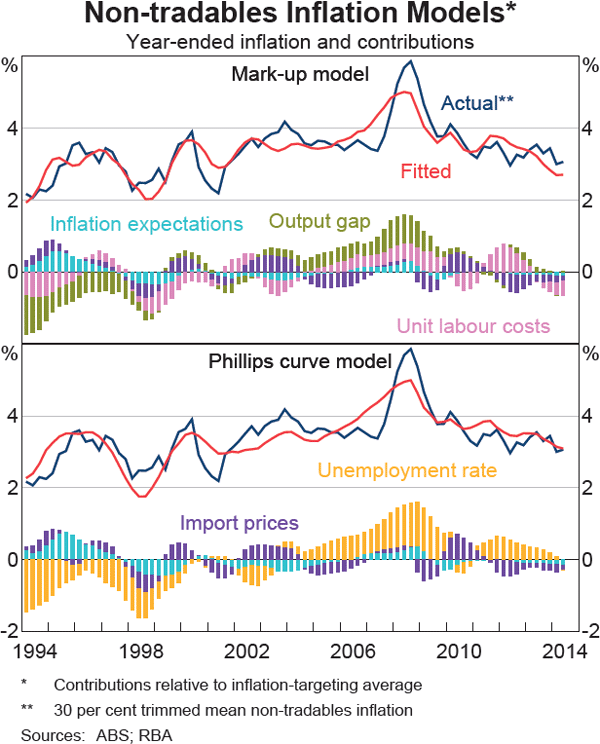
- Following the global financial crisis, there has been a decline in non-tradables inflation. This has been associated with an easing in capacity pressures, with unemployment, labour costs and the output gap all exerting less upward pressure on inflation, particularly over the past year. Accordingly, non-tradables inflation in year-ended terms has declined to around its lowest rate in over a decade.
Over the past few decades, non-tradables inflation appears to have become less sensitive to shocks. In particular, non-tradables inflation has become less sensitive to movements in the unemployment rate (Graph 7). This is the well documented ‘flattening of the Phillips curve’ that has also been observed for aggregate inflation in Australia (Kuttner and Robinson 2010; Norman and Richards 2010; Gillitzer and Simon forthcoming). Much of this change is thought to be due to the introduction of inflation targeting in the early 1990s and the associated anchoring of inflation expectations, although other factors may also have played a role.
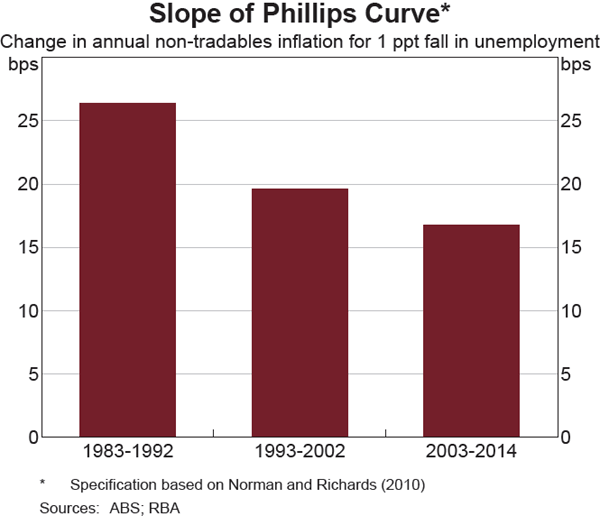
The Disaggregated (‘Bottom-up’) Perspective
The top-down macroeconomic perspective helps to explain non-tradables inflation using relatively few variables. However, in practice there are a wide range of other factors that may influence prices at an industry level, which may be more apparent when looking at prices for specific items or markets. Even so, a disaggregated bottom-up perspective also has drawbacks. In particular, it can be difficult to discern the effect of factors that have an economy-wide influence, such as wages or inflation expectations, amid the many other factors affecting individual prices from quarter to quarter.
With these caveats in mind, it is useful to consider a breakdown of the non-tradable items into three components, each of which represents between one-quarter and one-third of the aggregate non-tradables basket:[6]
- Housing services: the cost of new dwellings and rents (but excluding utilities prices, which are classified as administered items).
- Market services: other services for which pricing tends to be market-based, for example domestic household services (such as hairdressing), financial services, meals out & takeaway and domestic travel.
- Administered items: those for which prices are (at least partly) regulated or for which the public sector is a significant provider. This includes administered services, such as health, education and child care, as well as utilities.
Inflation outcomes have varied substantially across these components (Graph 8). These differences partly reflect variation in cost structures, with some items more intensive in their use of labour and others of capital (Graph 9).[7] The most labour-intensive items are administered services, for which labour costs account for up to three-quarters of final prices. Market services are the next most labour-intensive category, while at the other end of the spectrum, prices of items such as rental services and utilities mainly reflect capital costs. Inflation may also differ because these items are exposed to different sectors of the economy, and so may be subject to different demand and supply shocks. And finally, they may also have different pricing arrangements, with some prices tending to be determined more by market forces while others are subject to a degree of regulation. The remainder of this section explores these issues in more detail.

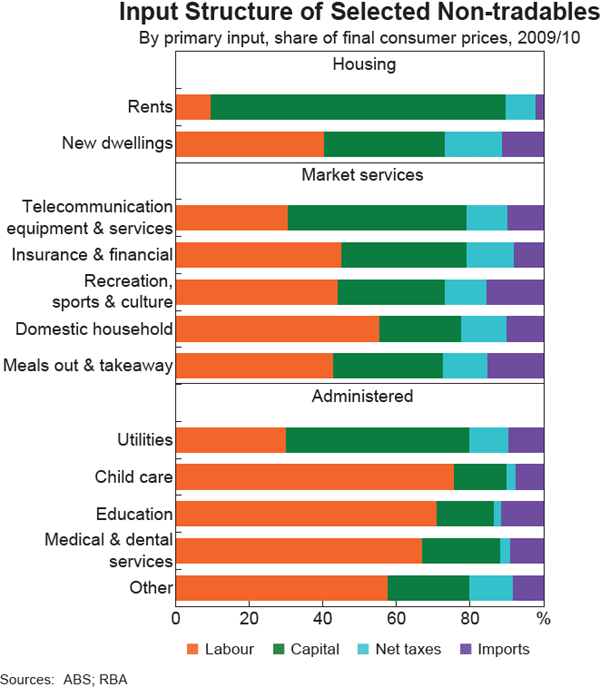
Market services
For market services, labour costs account for 40–50 per cent of final prices. As a result, inflation in this component is particularly sensitive to developments in the labour market. A mark-up model using unit labour costs is able to explain a substantial portion of the cycles seen in market services inflation over the past two decades (Graph 10). Indeed, labour market developments provide a better explanation of developments in this component than they do for overall non-tradables inflation, most notably when looking at the build-up of capacity pressures and inflation over 2007–08.
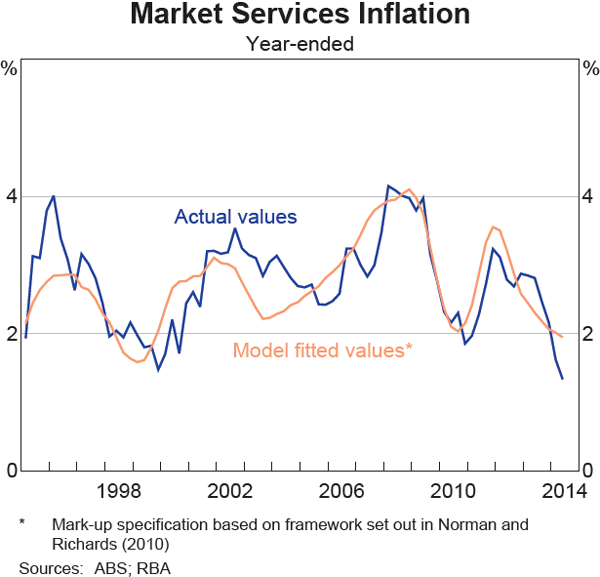
Housing
Changes in new dwelling cost inflation have moved in line with changes in the level of building approvals for detached houses, a proxy of demand for new housing (Graph 11). Periods of rising building approvals have seen higher inflation, in part owing to rising materials costs and builder margins, as well as stronger wage growth for construction workers.[8] Inflation in rents (measured in real terms) has tended to increase when the vacancy rate for rental properties has been low. Inflation in both new dwelling costs and rents increased in the 2007–08 period, during which, as discussed, non-tradables inflation cannot be fully explained by developments in the labour market. Inflationary pressures in both of these markets subsequently eased over the next few years as capacity pressures abated, and in spite of a general pick-up in the growth of labour costs. More recently, new dwelling cost inflation has picked up, consistent with accommodative monetary policy and a shift in government incentives towards new homes, and despite historically slow growth in labour costs.
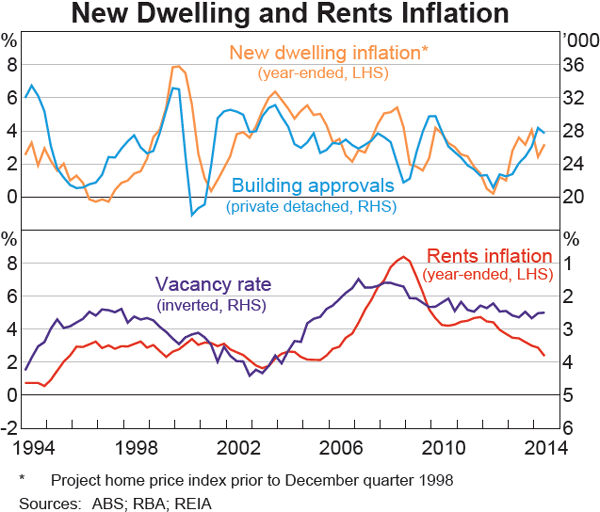
Administered items
Despite being among the most labour-intensive items in the whole CPI, administered services prices have a weak relationship with labour market conditions. Some of this reflects the occasional, large effect on prices from one-off policy changes. But even after controlling for these, administered services inflation has had little relationship with growth in unit labour costs (Graph 12). Rather, administered services inflation has been remarkably stable over time, at a relatively high level, averaging 5 per cent over the inflation-targeting period. Accordingly, administered prices are an important reason for the relatively high and stable nature of overall non-tradables inflation. Several related factors may have contributed to this:
- Strong demand. Demand for administered items has grown particularly strongly over time, and is relatively insensitive to the business cycle. Strong growth in demand for health services partly reflects households' increasing propensity to spend on health care as they become more affluent and as they age (the latter effects are expected to be larger in coming years; see RBA (2013)). Similarly, strong growth in real household incomes over recent decades may have also helped to ensure continued strength in demand for services such as private schooling.
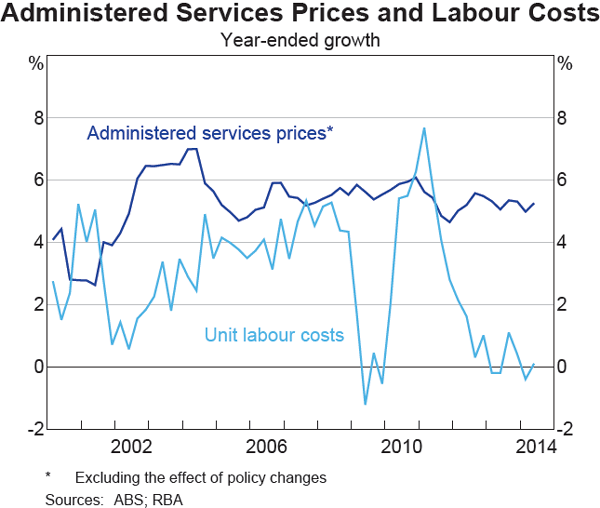
- Measurement problems. There are several factors that can impart an upward bias to measured price inflation over time and that are particularly pronounced for administered services (Jacobs, Perera and Williams 2014). In particular, it is difficult to assess and adjust for changes in the quality of services such as medical treatment and education over time.[9] Moreover, increases in measured health insurance premiums may have reflected greater utilisation of services (i.e. higher volumes) rather than higher prices (Biggs 2012).[10]
- Faster growth in labour costs. Growth in unit labour costs has been a little higher in administered services than other industries. This has reflected weaker productivity growth, which may be due to the difficulty in measuring productivity in this sector, but perhaps also because some firms in these industries may be less subject to competitive market forces.
Utilities prices have also made a large contribution to overall inflation, particularly since 2007 (Graph 13). This has been driven by a variety of factors not closely linked to overall economic conditions, including: a move towards cost-based pricing; an increase in investment to replace ageing infrastructure and improve capacity; and higher wholesale prices (Plumb and Davis 2010). In addition, incentives in the regulatory framework may have contributed to high levels of capital spending, while the introduction of the carbon price added to electricity and gas prices in 2012 (RBA 2012).
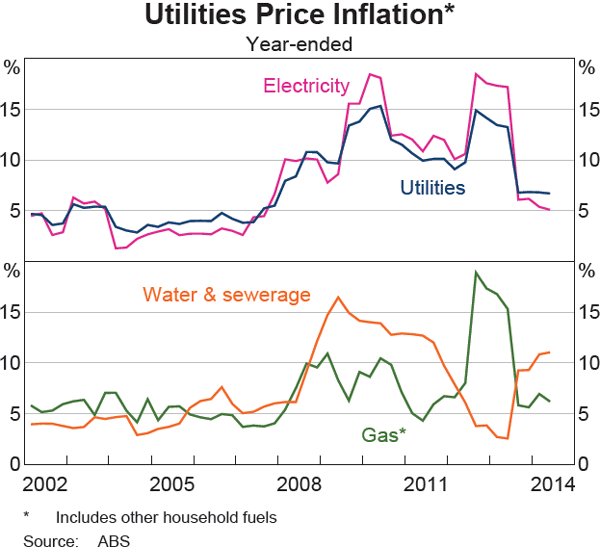
Conclusion
The prices of non-tradable items are strongly determined by domestic influences, consistent with their lower exposure to international competition. From a top-down perspective, spare capacity in the labour market and in the economy more broadly appears to be a key determinant. Accordingly, non-tradables inflation can also be interpreted as providing information regarding the extent of spare capacity in the domestic economy, and perhaps more so than for the aggregate CPI, which also includes the prices of tradable items. However, at a more granular level it is apparent that there is a wide range of factors affecting non-tradables inflation, including the extent of spare capacity in specific markets, such as housing, and non-market factors.
Appendix A Calculation of Input Cost Structures
This appendix sets out how input-output (IO) tables from the ABS are used to calculate the relative importance of different factor inputs as a share of final consumer prices. In particular, prices for different CPI expenditure classes (ECs) are broken down into capital (gross operating surplus plus gross mixed income), labour (compensation of employees) and imported inputs.[11] Some previous work has examined costs and margins along the supply chain.[12] However, little work appears to have linked these costs directly to final consumer prices, either in Australia or elsewhere.
The calculations combine information from two sources: the ‘standard’ IO tables and the ‘product level’ IO tables (Figure A1).[13] The standard IO tables can be used to look at the input structure of different industries and, in turn, groups of products that are produced by those industries. However, this information is not sufficient to determine the input structure of different expenditure classes in the CPI: it is not granular enough, and the prices are those received by producers. Unlike producer prices, consumer prices also include transport costs, margins and costs of retailers and wholesalers, as well as taxes and subsidies. The product level IO tables provide the additional information needed to tie the information in the standard IO tables to the CPI basket. In particular, they provide a mapping of individual products to expenditure classes in the CPI, as well as information on both producer and consumer prices. Various assumptions are required in making the calculations, meaning that the figures should be considered as indicative only. The calculations are made in a series of steps:
- Calculating input shares of domestic household consumption at the industry level. The factor input shares for an industry's total output, from all industries (i.e. final and intermediate), as a share of basic prices are obtained from the standard IO tables. These include the first round effects on the production of intermediate industries from an increase in output in the final industry, as well as second-round and subsequent effects on production. Household expenditure on the output of each industry is then assumed to have the same input structure as total output from that industry.
- Splitting household consumption into domestic and imported components. The standard IO release provides a breakdown of final use for product groups. The supply of product groups in this table includes both domestic production and imports. Imports that have gone to final use without any transformation by domestic industry are used to give the imported share of household consumption for each product group.
- Mapping industry input shares to product groups. The weight of each industry in the domestic production of each product group is calculated using the standard IO release. These weights are used to convert the input shares of industry production consumed by households calculated in step 1 into input shares of product groups. The input shares are then scaled down by the share of total household consumption that is produced domestically (step 2). The imported share of household consumption calculated in step 2 makes up the remainder.
- Mapping product group input shares to CPI ECs. The mapping provided in the product level IO release is used to convert product group input shares into more detailed product level input shares. These product input shares are mapped to CPI ECs, weighted by the amount of household consumption on each product. Where a product maps to multiple ECs, it is assumed that household consumption on that particular product is attributed evenly across the multiple ECs.
- Converting input shares from basic to purchasers prices. The EC input shares calculated in step 4 are scaled down by the ratio of household consumption at basic prices to household consumption at purchasers prices (from the product level release). The input shares of the margin components (e.g. retailers margins) are then obtained from the relevant industry input shares from step 1 and added to the scaled down input shares from other industries to obtain the total contribution of each factor input to final consumer prices.
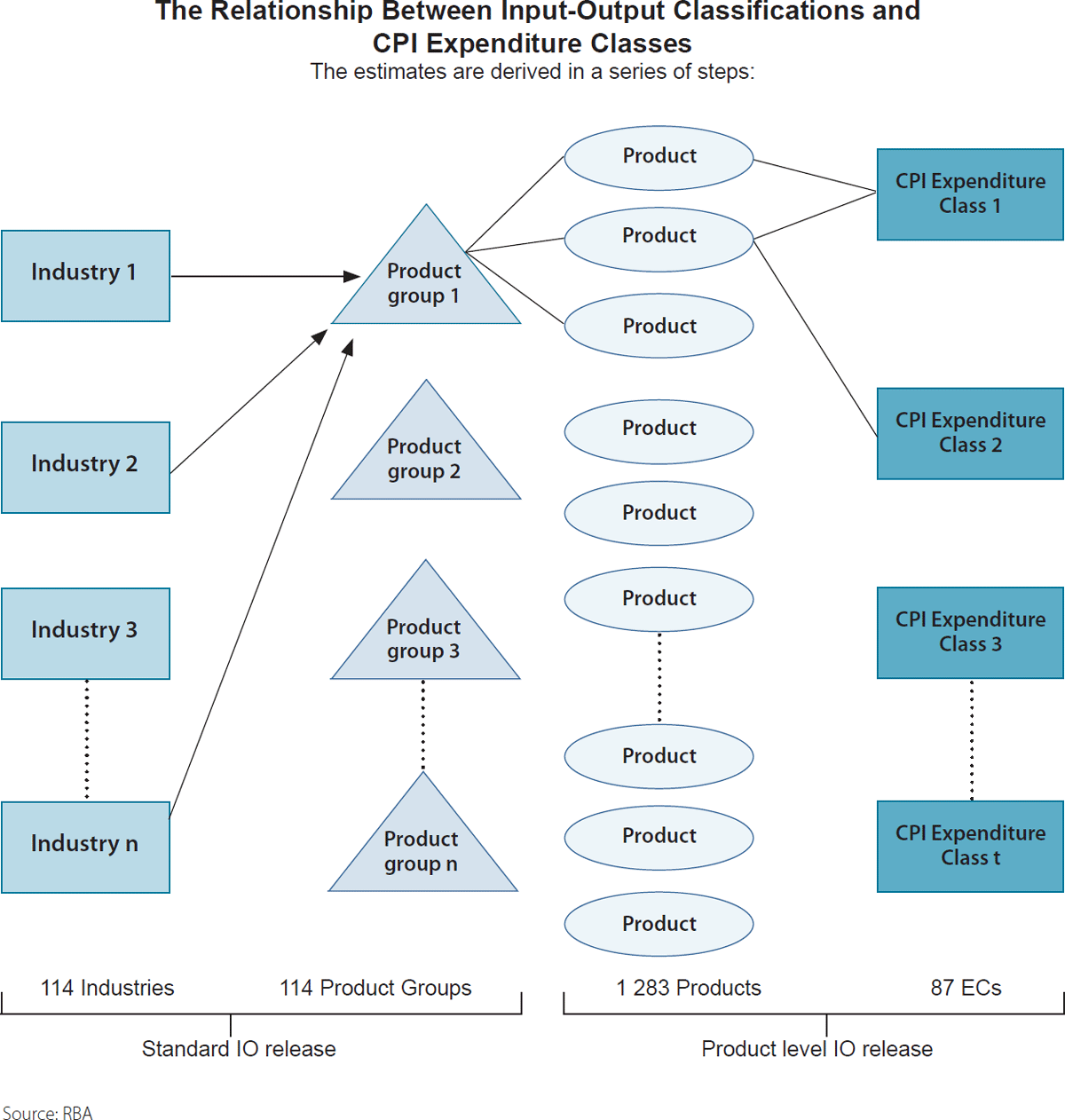
Appendix B Non-tradables Inflation Model Estimates
The econometric models of non-tradables inflation estimated in this article are specified in a similar fashion to those for aggregate inflation in Norman and Richards (2010). The estimated coefficients from the Phillips curve and mark-up models are presented in Table B1.
| Mark-up specification | Phillips curve specification | ||
|---|---|---|---|
| Variable | Coefficient(a) | Variable | Coefficient(a) |
| Constant | 0.016*** | Constant | −0.01* |
| Inflation expectations | 0.38*** | Inflation expectations | 0.48*** |
| Unit labour costs(b) | 0.83** | Unemployment rate (inverse)(c) | 0.16*** |
| Output gap | 0.28*** | Change in unemployment rate(d) | −0.003*** |
| Import price inflation(b) | 0.13 | Import price inflation(b) | 0.12 |
| Adjusted R-squared | 0.64 | Adjusted R-squared | 0.63 |
|
(a) Percentage point change in non-tradables inflation for 1 percentage point increase
in regressor variable; ***, ** and * denote statistical significance
at the 1, 5 and 10 per cent levels, respectively; coefficients multiplied
by 4 to represent annualised effects Sources: ABS; RBA |
|||
Footnotes
The authors are from Economic Analysis Department, and thank Alexander Ballantyne for assistance in preparing this article. [*]
See, for example, Dwyer and Lam (1994), Norman and Richards (2010) and Chung, Kohler and Lewis (2011). [1]
The threshold applied is 10 per cent of domestic supply; see Dwyer (1992) and ABS (2011). [2]
The details of these calculations are provided in Appendix A. Domestic costs also include net taxes. For tradable items, the domestic component of costs mainly reflects wages and margins in the goods distribution sector. [3]
Note that these figures are not comparable to the ‘threshold’ figure of 10 per cent used to classify tradable and non-tradable items. The latter refers only to imports of final goods and services (whereas imported inputs to non-tradable items are primarily intermediate inputs), but also includes exports. [4]
Excluding the effect of the tax changes of 1999–2000 and deposit & loan facilities from 2005 to 2011. [5]
More specifically, these categories are defined as follows: Housing services – rents, dwelling maintenance and new dwelling purchases; excludes administered items. Market services – domestic household services, recreational, sports & culture, telecommunication equipment and services, insurance & financial and meals out & takeaway; excludes deposit & loan facilities to June 2011, housing services and domestic travel. Administered items – utilities, education, child care, health services, property rates, urban transport fares, postal services and some motor vehicle services. Together, these expenditure classes cover around 90 per cent of the non-tradables basket. The remaining 10 per cent is primarily comprised of pharmaceuticals, domestic travel services and food items that are classified as non-tradable. [6]
The details of these calculations are provided in Appendix A. [7]
Changes to first home owner grants have also had an impact on price movements in this series. [8]
However, this would be expected to also affect the measurement of labour productivity and unit labour costs. [9]
There are other miscellaneous factors as well. For example, in the early 2000s medical indemnity insurance premiums rose rapidly due to a number of factors specific to that industry (Martin 2005). [10]
This is not a ‘pure’ measure of capital, as gross mixed income includes the labour income of unincorporated enterprises. However, the IO tables do not provide separate gross operating surplus and gross mixed income figures. [11]
For example, D'Arcy, Norman and Shan (2012). The breakdown here is different to that article, which was concerned with dividing the value of goods sold into the cost of the goods and margins earned by distributors. In contrast, this breakdown focuses on splitting the value of goods and services sold by their position in the supply chain. Imported goods that are sold to consumers without transformation by domestic industry are treated as an input in the distribution sector. [12]
The ‘standard’ IO tables are published as Input-Output Tables, 2009-10, ABS Cat No 5209.0.55.001. The ‘product level’ IO tables are published as Input-Output Tables (Product Details), 2009-10, ABS Cat No 5215.0.55.001. [13]
References
ABS (Australian Bureau of Statistics) (2011), ‘Consumer Price Index: Concepts, Sources and Methods’, ABS Cat No 6461.0.
Balassa B (1964), ‘The Purchasing Power Parity Doctrine: A Reappraisal’, Journal of Political Economy, 72, pp 584–596 .
Biggs A (2012), ‘Private Health Insurance Premium Increases – An Overview and Update’, Parliamentary Library Background Note, Canberra, 1 March.
Chung E, M Kohler and C Lewis (2011), ‘The Exchange Rate and Consumer Prices’, RBA Bulletin, September, pp 9–16.
D'Arcy P, D Norman and S Shan (2012), ‘Costs and Margins in the Retail Supply Chain’, RBA Bulletin, June, pp 13–22.
Dwyer J (1992), ‘The Tradable Non-Tradable Dichotomy: A Practical Approach’, Australian Economic Papers, December, pp 443–458.
Dwyer J and R Lam (1994), ‘Explaining Import Price Inflation: A Recent History of Second Stage Pass-through’, RBA Research Discussion Paper No 9407.
Gillitzer C and J Simon (forthcoming), ‘Inflation Targeting: A Victim of its Own Success’, Paper presented to the Reserve Bank of New Zealand Conference, ‘Reflections on 25 Years of Inflation Targeting’, Wellington, 1–3 December.
Jacobs D, D Perera and T Williams (2014), ‘Inflation and the Cost of Living’, RBA Bulletin, March, pp 33–46.
Kuttner K and T Robinson (2010), ‘Understanding the Flattening Phillips Curve’, The North American Journal of Economics and Finance, 21(2), pp 110–125.
Lowe P (2011), ‘Changing Patterns in Household Saving and Spending’, Address to the Australian Economic Forum, Sydney, 22 September.
Martin H (2005), ‘Medical Indemnity Insurance: Industry Update’, APRA Insight, 1st Quarter.
Norman D and A Richards (2010), ‘Modelling Inflation in Australia’, RBA Research Discussion Paper No 2010-03.
Plumb M and K Davis (2010), ‘Developments in Utilities Prices’, RBA Bulletin, December, pp 9–18.
Plumb M, C Kent and J Bishop (2013), ‘Implications for the Australian Economy of Strong Growth in Asia’, RBA Research Discussion Paper No 2013-03.
RBA (Reserve Bank of Australia) (2012), ‘Box D: Recent Developments in Utilities Prices’, Statement on Monetary Policy, November, pp 62–63.
RBA (2013), ‘Box C: The Household Services Sector’, Statement on Monetary Policy, November, pp 42–43.
Samuelson P (1964), ‘Theoretical Notes on Trade Problems’, The Review of Economics and Statistics, 23, pp 1–60.
Steenkamp D (2013), ‘Productivity and the New Zealand Dollar: Balassa-Samuelson Tests on Sectoral Data’, Reserve Bank of New Zealand Analytical Note Series AN 2013/01.